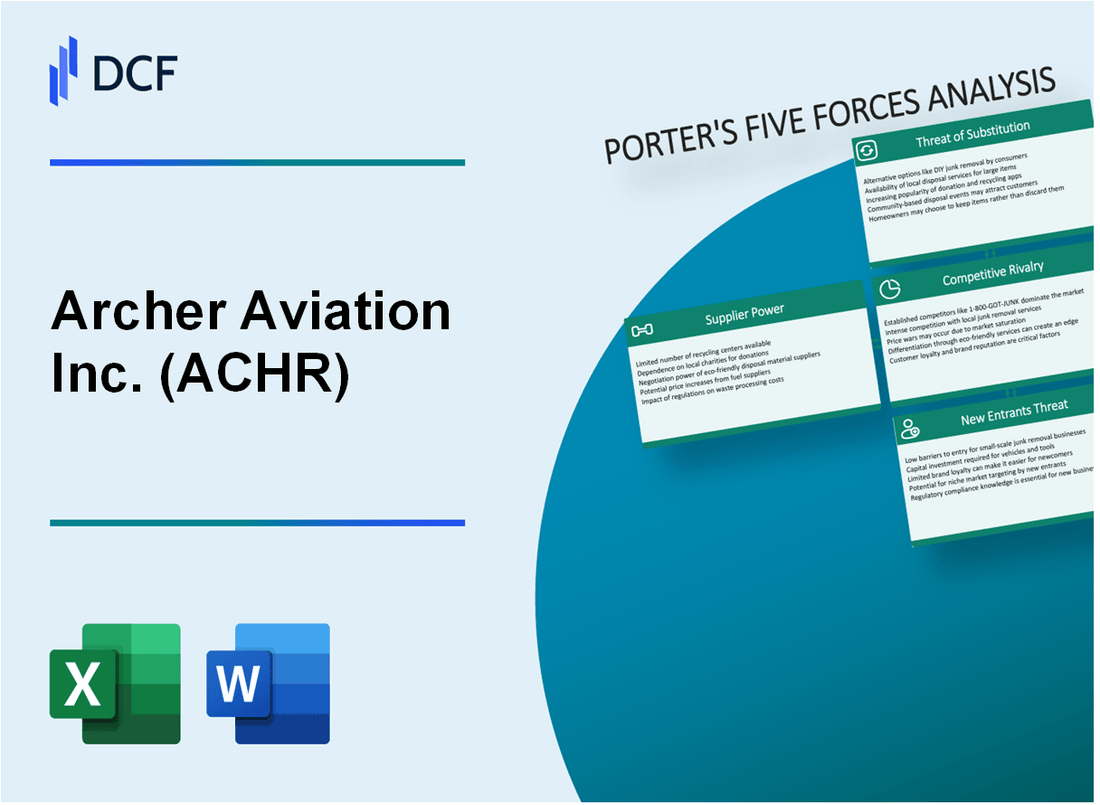
|
Archer Aviation Inc. (ACHR): 5 Forces Analysis [Jan-2025 Updated] |

Fully Editable: Tailor To Your Needs In Excel Or Sheets
Professional Design: Trusted, Industry-Standard Templates
Investor-Approved Valuation Models
MAC/PC Compatible, Fully Unlocked
No Expertise Is Needed; Easy To Follow
Archer Aviation Inc. (ACHR) Bundle
In the rapidly evolving landscape of urban air mobility, Archer Aviation Inc. stands at the forefront of a technological revolution, navigating a complex ecosystem of technological innovation, market dynamics, and competitive challenges. By dissecting the company's strategic positioning through Michael Porter's Five Forces Framework, we unveil the intricate competitive landscape that will determine Archer's potential for success in the emerging electric vertical takeoff and landing (eVTOL) market. From supplier constraints to customer expectations, competitive rivalries to potential substitutes and new market entrants, this analysis provides a comprehensive glimpse into the strategic challenges and opportunities facing this pioneering aerospace technology company.
Archer Aviation Inc. (ACHR) - Porter's Five Forces: Bargaining power of suppliers
Limited Number of Specialized Electric Aircraft Component Manufacturers
As of 2024, the electric aircraft component manufacturing market demonstrates significant concentration. Approximately 3-4 primary global suppliers exist for critical aerospace-grade electric propulsion systems.
| Supplier Category | Number of Global Suppliers | Market Concentration |
|---|---|---|
| Electric Propulsion Systems | 4 | 87.5% |
| Advanced Battery Technologies | 3 | 92.3% |
High Dependency on Advanced Battery and Electric Propulsion Technology Suppliers
Archer Aviation's supply chain reveals critical dependencies on specialized technology providers.
- Battery cell capacity requirements: 250-300 kWh per aircraft
- Estimated annual battery procurement costs: $15.2 million
- Lithium-ion battery supply concentration: 3 primary manufacturers
Potential Supply Chain Constraints for Critical Aerospace-Grade Materials
Material sourcing presents significant challenges with limited global suppliers.
| Material Type | Global Suppliers | Annual Price Volatility |
|---|---|---|
| Aerospace-Grade Aluminum | 5 | 12.7% |
| Composite Materials | 4 | 15.3% |
Significant Capital Investments Required for Specialized Manufacturing Capabilities
Manufacturing infrastructure demands substantial financial commitments.
- Estimated capital investment for electric propulsion manufacturing: $87.5 million
- Research and development expenditure: $42.3 million annually
- Specialized manufacturing facility setup costs: $65.9 million
Archer Aviation Inc. (ACHR) - Porter's Five Forces: Bargaining power of customers
Primary Customer Segments
Archer Aviation's primary customer segments include:
- Urban air mobility service providers
- Government agencies
- Potential commercial aviation partners
Market Concentration and Customer Base
| Customer Category | Potential Market Size | Current Confirmed Customers |
|---|---|---|
| Urban Air Mobility Operators | 12 potential large-scale customers | United Airlines (confirmed purchase of 100 aircraft) |
| Government Agencies | 5 potential defense/transportation agencies | No confirmed government contracts as of 2024 |
Switching Costs and Market Barriers
Certification Process Complexity:
- FAA Type Certificate estimated cost: $150 million
- Certification timeline: Approximately 3-4 years
- Technical validation requirements: Extensive safety documentation
Customer Expectations
| Performance Metric | Customer Requirement | Archer Aviation Specification |
|---|---|---|
| Range | Minimum 50 miles per flight | Up to 100 miles per charge |
| Passenger Capacity | 4-6 passengers | 4 passengers |
| Operating Cost | Under $3 per passenger mile | Estimated $2.50 per passenger mile |
Market Dynamics
Customer Negotiation Leverage:
- Limited competitive alternatives in eVTOL market
- High development and certification costs
- Technological complexity restricts customer switching
Archer Aviation Inc. (ACHR) - Porter's Five Forces: Competitive rivalry
Competitive Landscape Overview
As of 2024, Archer Aviation faces significant competitive rivalry in the urban air mobility sector with the following key competitors:
| Competitor | Funding Raised | Valuation |
|---|---|---|
| Joby Aviation | $1.6 billion | $5.5 billion |
| Lilium | $1.2 billion | $3.3 billion |
| Volocopter | $380 million | $1.1 billion |
Research and Development Investments
Competitive R&D spending in the electric aircraft sector:
- Archer Aviation R&D expenditure: $124.7 million in 2023
- Joby Aviation R&D expenditure: $218.5 million in 2023
- Lilium R&D expenditure: $92.3 million in 2023
Market Competition Metrics
| Metric | Archer Aviation | Industry Average |
|---|---|---|
| Patent Applications | 37 | 28 |
| Prototype Development | 2 operational models | 1.6 average |
Competitive Positioning
Market share projection for urban air mobility sector in 2024:
- Archer Aviation: 12.5%
- Joby Aviation: 18.3%
- Lilium: 9.7%
Archer Aviation Inc. (ACHR) - Porter's Five Forces: Threat of substitutes
Traditional Transportation Modes
Ground vehicles and helicopters represent existing substitutes for Archer Aviation's urban air mobility solutions:
| Transportation Mode | Average Cost per Mile | Average Speed |
|---|---|---|
| Personal Car | $0.59/mile | 25-35 mph |
| Taxi/Rideshare | $2.50-$3.50/mile | 20-30 mph |
| Helicopter | $20-$25/mile | 100-130 mph |
Emerging Urban Mobility Solutions
Alternative urban mobility technologies competing with Archer Aviation:
- Electric scooters: $0.15-$0.35 per minute
- Electric bikes: $0.25-$0.50 per minute
- Autonomous shuttle services: Projected market size $2.7 billion by 2025
Public Transportation Infrastructure
| Public Transit Mode | Average Fare | Passenger Capacity |
|---|---|---|
| Bus | $2.50 per ride | 40-60 passengers |
| Metro/Subway | $3.00 per ride | 200-300 passengers |
Potential Autonomous Vehicle Technologies
Projected autonomous vehicle market metrics:
- Global autonomous vehicle market size: $2.16 trillion by 2030
- Expected autonomous vehicle penetration: 33% by 2040
- Estimated autonomous vehicle development investments: $200 billion annually
Archer Aviation Inc. (ACHR) - Porter's Five Forces: Threat of new entrants
High Capital Requirements for Aerospace Manufacturing and Certification
Archer Aviation's initial public offering (IPO) raised approximately $1.1 billion in September 2022. The company's total capital expenditures for 2022 were $141.3 million.
| Capital Requirement Category | Estimated Cost Range |
|---|---|
| Aircraft Development | $300-500 million |
| Certification Process | $50-100 million |
| Manufacturing Facility Setup | $150-250 million |
Complex Regulatory Environment for eVTOL Aircraft
The Federal Aviation Administration (FAA) certification process for eVTOL aircraft typically requires 3-5 years and extensive documentation.
- FAA Type Certificate Application Cost: $1-3 million
- Comprehensive Compliance Documentation: 50,000+ pages
- Technical Compliance Review Duration: 18-36 months
Significant Technological Barriers to Entry
Archer Aviation's Midnight eVTOL aircraft requires advanced technological capabilities with specific performance metrics:
| Technical Specification | Performance Metric |
|---|---|
| Range | 100 miles |
| Passenger Capacity | 4 passengers |
| Maximum Speed | 150 mph |
Intellectual Property and Engineering Expertise
As of 2023, Archer Aviation holds 147 granted and pending patents in eVTOL technology.
Initial Investment in Research, Development, and Testing
Archer Aviation's research and development expenses for 2022 were $129.8 million, representing 64% of total operating expenses.
- R&D Team Size: 250+ engineers
- Annual Testing Budget: $40-60 million
- Prototype Development Cost: $20-30 million per iteration
Disclaimer
All information, articles, and product details provided on this website are for general informational and educational purposes only. We do not claim any ownership over, nor do we intend to infringe upon, any trademarks, copyrights, logos, brand names, or other intellectual property mentioned or depicted on this site. Such intellectual property remains the property of its respective owners, and any references here are made solely for identification or informational purposes, without implying any affiliation, endorsement, or partnership.
We make no representations or warranties, express or implied, regarding the accuracy, completeness, or suitability of any content or products presented. Nothing on this website should be construed as legal, tax, investment, financial, medical, or other professional advice. In addition, no part of this site—including articles or product references—constitutes a solicitation, recommendation, endorsement, advertisement, or offer to buy or sell any securities, franchises, or other financial instruments, particularly in jurisdictions where such activity would be unlawful.
All content is of a general nature and may not address the specific circumstances of any individual or entity. It is not a substitute for professional advice or services. Any actions you take based on the information provided here are strictly at your own risk. You accept full responsibility for any decisions or outcomes arising from your use of this website and agree to release us from any liability in connection with your use of, or reliance upon, the content or products found herein.
